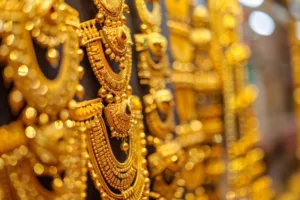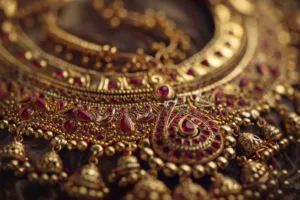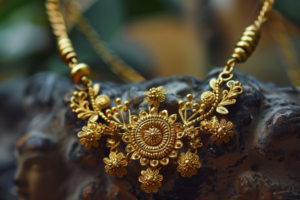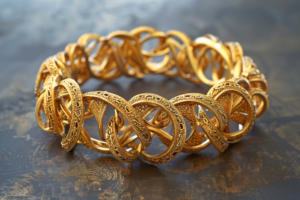Gold is of immense cultural and economic importance in Tamil culture. It's a symbol of prosperity, wealth, and tradition, often gifted during Tamil New Year celebrations. Gold ornaments are deeply ingrained in Tamil rituals, fashion, and architecture. While its significance has evolved, gold remains a cherished asset passed down through generations, reflecting the enduring richness of Tamil heritage.

Understanding the Role of Gold in Tamil Culture
Gold is distinctive in Tamil culture, specifically highlighted during the vibrant Tamil New Year gold traditions. It is significant in the Tamil New Year jewellery traditions, where families often exchange gold ornaments for celebrations. The allure of traditional Tamil gold jewellery remains strong, especially during festivals, with items such as necklaces and bangles symbolising prosperity and tradition. Many also see gold gifts for Tamil New Year as auspicious, aligning with the deep cultural value placed on gold ornaments in Tamil culture. The Alfa Jewellers Tamil gold collection offers an exquisite range of gold jewellery for Tamil festivals, reflecting the enduring heritage of Tamil gold jewellery for festivals.
The Historical Significance of Gold in Tamil Society
Gold has been integral to Tamil culture for centuries, signifying wealth and cultural heritage. The ancient Tamil kingdoms, known for their prosperity, often used gold ornaments in Tamil culture to decorate temples and architectural marvels. The inscriptions and artefacts found in archaeological sites attest to the importance of gold in Tamil culture in rituals and ceremonies, linking it to divine blessings and royal patronage.
Throughout history, gold in Tamil culture has been a critical medium of exchange in trade, reinforcing its significance in social and economic structures. It has served as an indicator of status, with families possessing traditional Tamil gold jewellery often regarded as more prosperous and influential within their communities. The craftsmanship involved in creating intricate Tamil gold jewellery for festivals has also been a point of pride, showcasing the skills of artisans who have passed down their techniques through generations. This artistry reflects Tamil New Year gold traditions and is a testament to the historical trade routes that brought gold from distant lands, further enriching the region's cultural tapestry.
Gold as a Symbol of Prosperity and Wealth
Gold in Tamil culture is not merely a metal but a representation of prosperity and good fortune. Its lustrous appearance and enduring qualities resonate with concepts of permanence and stability. Gold ornaments in Tamil culture, especially traditional Tamil gold jewellery, are often passed down through generations, symbolising familial lineage and the hopes for continued wealth. Gifting gold during Tamil New Year and other significant life events, such as births and weddings, is deeply rooted in tradition.
Families often invest in gold jewellery for Tamil festivals to secure their future and ensure their descendants are well-provided. This connotation extends beyond financial aspects; it encapsulates the blessings of happiness, health, and success. Consequently, gold jewellery for Tamil festivals is prevalent in various celebratory contexts, particularly during milestones and significant events such as weddings and celebrations. For instance, gold is often worn during the festival of Pongal to signify abundance and gratitude for the harvest.
Additionally, the elaborate rituals surrounding Tamil weddings frequently involve the exchange of traditional Tamil gold jewellery, believed to bring prosperity to the couple's new life together. The significance of gold gifts for Tamil New Year and other traditions highlights its role as a bridge between the material and the spiritual, reinforcing the belief that wealth when shared and celebrated, can foster communal harmony and joy. The Alfa Jewellers Tamil gold collection offers a range of beautiful Tamil New Year jewellery traditions for those looking to honour these customs.

The Importance of Gold in Tamil New Year Celebrations
Gold plays a significant role in Tamil New Year celebrations. It's considered a symbol of prosperity, wealth, and good fortune. Many families display gold jewellery or coins as the first thing they see on New Year's morning, believing it will bring blessings for the year ahead. This tradition highlights the cultural importance of gold in Tamil culture and its association with auspicious beginnings.
Gold in Traditional Tamil New Year Rituals
The Tamil New Year celebrated in the month of Chithirai, is a time when gold takes centre stage in rituals and festivities. On this auspicious day, it is customary for families to don their finest gold jewellery, symbolising new beginnings and prosperity. Rituals often include presenting gold items to deities as offerings for blessings in the coming year.
Families often engage in various Pooja (prayer) rituals, where gold is worn and installed on the altar as part of worship. This tradition reinforces the belief that gold possesses divine qualities that can attract good fortune and positive energy. Placing gold on the altar is steeped in significance, as it is believed to invite the blessings of the divine into the household, ensuring protection and prosperity for the family throughout the year.
The Symbolism of Gold in Tamil New Year Festivities
Gold represents abundance and wealth during the Tamil New Year traditions, and it is a token of gratitude for the past year's blessings. The vibrant display of traditional Tamil gold jewellery is a noticeable adornment during festive gatherings, with families showcasing their collections in elaborate displays and dances. The shimmering gold ornaments in Tamil culture enhance the visual appeal of the celebrations and remind people of their cultural heritage and the values passed down through generations.
Moreover, gifting gold to relatives, friends, and neighbours during these festivities signifies goodwill and reinforces social bonds. It is a gesture that embodies the spirit of sharing and togetherness, core values in Tamil culture. This practice of exchanging gold is often accompanied by heartfelt wishes for health, happiness, and prosperity, fostering a sense of community and interconnectedness. As families gather to celebrate, gold is a unifying element, linking individuals to their roots and each other, creating a tapestry of shared experiences that enriches the Tamil New Year festivities.

The Influence of Gold on Tamil Art and Aesthetics
Gold has profoundly influenced Tamil art and aesthetics. Its inherent value, lustrous appearance, and malleability have made it a prized material for centuries. Tamil artisans have skillfully incorporated gold into various art forms, including jewellery, sculpture, and architecture. The intricate designs and delicate craftsmanship often showcased in these works testify to Tamil culture's enduring allure of gold.
Gold in Tamil Jewellery and Fashion
The craftsmanship of Traditional Tamil gold jewellery is renowned. Intricate designs often incorporate gold as the primary material, showcasing the significance of gold ornaments in Tamil culture. Traditional designs such as the 'Mangal Sutra' and 'Vanki' epitomise the exquisite artistry involved, often embellished with precious stones. Gold jewellery for Tamil festivals is not just a fashion statement; it embodies cultural narratives, reflecting societal values and aesthetics. Many families also embrace Tamil New Year gold traditions, where gold gifts for Tamil New Year are exchanged as a sign of prosperity and goodwill. Alfa Jewellers Tamil gold collection offers a wide range of these timeless pieces, celebrating Tamil New Year jewellery traditions.
Fashion in Tamil culture, particularly for women, is significantly defined by gold adornments. From classical dances to festive attire, gold jewellery is pivotal in enhancing the overall aesthetic appeal and signifies a person's socio-cultural identity. The significance of gold can also be observed during important life events such as weddings and festivals, where the quantity and quality of gold worn can denote familial status and prosperity. The vibrant colours of silk sarees paired with the sparkle of gold create a visual harmony that is both captivating and culturally resonant, making these adornments a vital part of Tamil heritage.
The Use of Gold in Tamil Architecture and Design
Gold also finds its way into Tamil architecture, particularly in temples where immense care is taken to use gold in embellishments. Many temples feature gold-plated domes and intricate carvings that tell stories of deities and mythology. These architectural marvels shine brightly under the sun, symbolising spiritual wealth. Gold in these sacred spaces is not merely for decoration; it elevates the spiritual experience, inviting devotees to engage with the divine through the luxury surrounding them.
In addition to temples, modern Tamil architecture sometimes incorporates gold leaf in interior design, creating spaces that evoke luxury and elegance. This blend of tradition with contemporary aesthetics showcases the adaptability of gold's significance over time. The infusion of gold accents in homes and public buildings reflects a desire to connect with cultural roots while embracing modernity. Designers often draw inspiration from traditional motifs, ensuring that the essence of Tamil artistry is preserved even as new architectural trends emerge, thus creating a dialogue between the past and the present.

The Economic Implications of Gold in Tamil Culture
Gold has long held a significant place in Tamil culture, not only as a symbol of wealth and status but also as a vital economic asset. From ancient times, gold has been used as a medium of exchange, a store of value, and an investment vehicle. Its economic importance has been deeply intertwined with Tamil society's social and cultural fabric, influencing trade, finance, and the overall economy.
Gold as a Form of Investment in Tamil Society
Beyond its aesthetic and cultural importance, gold in Tamil culture holds a crucial place as an investment asset. Many families view gold ornaments in Tamil culture as a haven, especially amid economic uncertainties. Buying traditional Tamil gold jewellery—jewellery, coins, or bars—is deeply embedded in Tamils' financial habits.
Investing in gold is considered a judicious financial decision, often employed to secure wealth for future generations. This investment culture places gold at the crossroads of tradition and modern economic strategy, demonstrating its relevance across generations.
The Impact of Gold on Tamil Economy and Trade
Gold significantly influences the Tamil economy through trade and local businesses. The jewellery industry thrives in Tamil Nadu, driving economic activity and providing numerous job opportunities. Local artisans and craftsmen continually create exquisite gold items, assisting in preserving traditional skills while catering to contemporary demands.
The demand for gold shows resilience during economic fluctuations, often leading to increased investment in mining and mineral extraction industries. This boosts local economies and positions Tamil Nadu as a critical player in the global gold market.

The Future of Gold in Tamil Culture and Traditions
The future of gold in Tamil culture and traditions remains intertwined with its historical significance. While modern trends and economic factors may influence its use, gold's enduring value as a symbol of wealth, status, and auspiciousness will likely persist. It will continue to play a key role in Tamil New Year gold traditions, Tamil New Year jewellery traditions, and traditional Tamil gold jewellery. Gold ornaments in Tamil culture will remain a cherished element in weddings, religious ceremonies, and festivals. The Alfa Jewellers Tamil gold collection offers stunning designs for such occasions. Gold gifts for Tamil New Year and gold jewellery for Tamil festivals further reflect the metal's timeless beauty and cultural heritage.
Modern Interpretations of Gold in Tamil Society
As society evolves, so does the perception and role of gold in Tamil culture. Contemporary interpretations often blend traditional significance with modern aesthetics and practices. Young generations are embracing innovative designs while respecting gold's timeless essence. Eco-conscious trends, such as ethical sourcing and sustainable jewellery, shape how gold is perceived and used, driving demand for responsibly crafted items that maintain cultural integrity.
The Evolving Role of Gold in Tamil New Year Celebrations
Gold's role in Tamil New Year celebrations is also transforming. While traditional rituals remain intact, there is a growing trend for minimalist designs and lightweight ornaments, reflecting a shift in lifestyle preferences.
Moreover, online shopping and digital platforms have broadened accessibility, allowing families to explore various designs and investment options. Despite these changes, the essence of gold as a symbol of prosperity during Tamil New Year remains steadfast, highlighting its enduring significance in Tamil culture.
In conclusion, gold continues to weave through the fabric of Tamil culture, affirming its relevance from historical roots to modern interpretations. As celebrations evolve and embrace new trends, gold will undoubtedly remain at the heart of Tamil identity, symbolising wealth and a vibrant cultural legacy.





Article
The Significance of Gold in Tamil Culture: Celebrating Tamil New Year Traditions
Gold, a symbol of prosperity and wealth, is deeply rooted in Tamil culture. During Tamil New Year, gifting gold is considered auspicious, bringing blessings for the year ahead. Traditional gold ornaments, such as the "Thaali" and "Vanki," are often worn and gifted during this time.